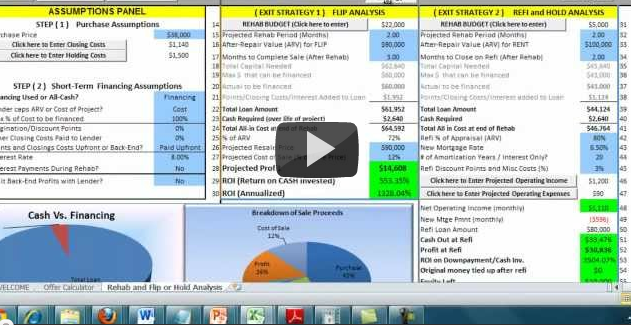How I Analyze a Real Estate Deal Step by Step
Post on: 6 Апрель, 2015 No Comment

All of our investments to date are single family residential but thats about to change. Single family is great to get your feet wet, but the amount of time and effort involved to take it to the next level is extortionate. So, were testing the waters in other arenas. The options on the table are either buying apartment complexes (100+ units) or going commercial. Were running both down, but at the moment were excited by a package of outlots which will be auctioned by a bankruptcy trustee next week. Since at least one or two you seem to care about what we do, I thought I would walk you through the process of how I analyze a real estate deal.
Determine Timeline
Theres no shortage of investment opportunities. Youve heard it before but the deal of a lifetime comes along once a week- assuming youre looking! So we prioritize our time, and when a property is presented to us, we first determine how fast we need to act. If its been on LoopNet for 4 months, well stick it on the back burner no matter how appealing the numbers.
For todays lesson in how to analyze a real estate deal, Im going to pick just one of the properties on the block next week.
Crunch the Numbers
When I see a property in person I sometimes becomeattached. Ive caught myself saying Ooh I love those windows! and check out the well manicured lawns, it must be a nice area!
The trouble is our investors dont give a flying F about any of those things. Most of them will never even see the property they just want a check every quarter.
Why waste my time? I dont visit at a deal until I get actual numbers (not just what the claimed NOI is on LoopNet). One day, when weve accumulated a large cash flow base, I might consider more speculative deals, but that is not this day.
The trustee for this property provided us with very thorough numbers:
Now when we invest, our first criteria is a 10% cash on cash return. Since we are too short on time to line up financing, well be buying this property in cash. Thus a 10% return gives us a purchase price of $1,028,710.70 (102,871.07/.10).
That should be our maximum bid, correct?
Not just yet.
Calculate Income/Expense Discrepancy
For triple net leases (which these are) our non base rent income should offset the operational expenses (excluding management fees). Lets see if they do in this case.
The relevant income items are reconciliation, CAM, administrative fees, real estate taxes, and insurance. These all add up to $8,782.05.
The corresponding expense items (CAM, real estate taxes, and insurance) add up to $12,817.36.
Something is off. These items should have the same sum, but the expenses are mucho mas grande. In theory, the owner should be collecting an additional $4,035.31. I can see three potential reasons for this:
- The lease years dont line up with the fiscal years, and the difference is thanks to drift.
- The leases state CAM cannot be increased more than 5% per year. A quick jump in expenses might max this out.
- Its an absentee landlord who has been doing a poor job managing the properties and didnt collect as much as he should. Based on other information, which Ill come to, I think this is the most likely explanation.
If the reason is option 1 or 3 we should be able to fully recoup this discrepancy. If its option 2, were SOL. To keep things simple and conservative, Im going to say we will recoup half, thus our NOI increases by $4,035.31/2 = $2,017.66.
Get On the Ground Information
Those calculations are a great starting point, but we now we need details about the property itself. Unfortunately, I dont live anywhere near it and time is of the essence so I cant visit.
Side note, we did visit a number of the properties in our area last week (drove well over 10 hours). In fact we wound up in Lima, Ohio and Ben Leybovich was good enough to meet up with us for a half hour or so. The same crew built all of these properties and the two we saw were exact replicas of one another. From everything I can tell, the property in question is the same. Normally I wouldnt dream of bidding on a property sight unseen, but Im confident I know what to expect.
Rather than trekking there myself, I did the next best thing: I called all of the tenants in the buildings. Yep, I plugged in the addresses, pulled the business names from the leases, and googled their numbers. I spent about three hours on the phone today with tenants all over the country (my favorite accent was Minnesotan, or, as I like to call it, Canadian).
For this property, I got a hold of a business owner that has been a tenant for 10 years. Here are the highlights of the conversation:
- When he first moved into the building there was a management company in place, but the property owner fired them after a month or two.
- In the last 10 years he has never seen the property owner.
- The one vacant unit has a small for lease sign, but the phone number it shows is out of service.
- The roof leaked and the trustee repaired it in preparation for the auction, however, there is still water damage in the walls and the back door. The tenant is pissed off that they didnt fix it for over a year and wont sign another lease until they fix the damage (hes on a month to month lease since they couldnt come to terms).
- The property owner didnt properly divide the units. The ducting and electricity are crossed/shared and need fixed.
- There are two other strip centers very nearby which are full occupied.

Calculate Offsets
Now weve a bunch of information, and get to figure out how to adjust our numbers.
Mismanagement
Im not going to do anything with the fact that this property has been mismanaged. If I start down the path of I could do it so much better I become a speculator. On this property, I think its true, but I dont want to bake that into my numbers.
To fix the poor division, repair the water damage, and give myself a little cushion in case the roof repair didnt take, Im setting aside $60,000.
Vacancy and Turnover
There is one empty unit, but lets plan for more. Considering the high occupancy in the area Im chucking on a measly 5%. That brings our estimated vacancy to 15%, which is super conservative.
Everyone has to make money, and were no exception. Technically, we can take up to a 20% deal oversight fee, but we will cut into that at the time of auction. I ran two scenarios, one at 10% and one at 20%.
Wrap It Up: The Final Tally as We Analyze a Real Estate Deal
What do we get when we add all that together?
So, if we take a 10% payout, we are willing to bid
$840k.
Keep in mind this is one of many units being auctioned. Our true maximum will be determined by the auction order and how much capital we have already invested. If this is the first property on the block or were low on funds, well want closer to that 20% number. If its the last one of the day and weve not bought anything, well start bumping up on the 10% payout.
Ill let you know how it goes!
If you folks like this type of article, give me a heads up. There is no shortage of analyze a real estate deal material.
As you probably figured out, I spend a lot of time exploring numerous aspects of real estate (check out my personal blog or other posts on BiggerPockets if you dont believe me). If you have a burning desire to have me analyze some real estate related topic, throw me a comment or a tweet!
Free eBook from BiggerPockets!
Get The Ultimate Beginnner’s Guide to Real Estate Investing for FREE — read by more than 100,000 people — AND get exclusive real estate investing tips, tricks, and techniques delievered straight to your inbox twice weekly!
- Actionable Advice for Getting Started,
- Discover the 10 Most Lucrative Real Estate Niches,
- Learn how to get started with or without money,
- Explore Real-Life Strategies for Building Wealth,
- And a LOT more
Sign up below to download the eBook for FREE today!














